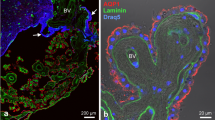Summary
Choroid plexus papillomas are usually easily distinguishable from papillary ependymomas by their delicate fibrovascular stroma and their cytologic similarity to normal choroid plexus epithelium. Exceptionally, however, examples are met which give rise to diagnostic difficulty. We therefore tested 22 choroid plexus papillomas for the presence of glial fibrillary acidic (GFA) protein using the immunoperoxidase technique. Positivity for the protein was found focally in epithelial tumor cells in nine of the 22 papillomas. All were in adults ranging from 19–66 years of age. Eight of the nine tumors originated in the 4th ventricle or from one of its lateral recesses. In six papillomas showing GFA protein in the cells, intracellular fibrils were found in a small number of elongated epithelial cells with the PTAH and/or Masson trichrome stains; in all these six cases, the GFA protein-positive cells were considerably more numerous than cells containing fibrils. Normal choroid plexus epithelium lacks GFA protein, but pathologically altered ependymal cells are often GFA protein-positive. Our findings therefore suggest that focal divergent glial (presumably ependymal) differentiation may be expressed in neoplastic choroid plexus epithelium, consistent with the origin of this epithelium from primitive neuroepithelial (ventricular) cells.
Similar content being viewed by others
References
Bignami A, Eng LF, Dahl D, Uyeda CT (1972) Localization of the glial fibrillary acidic protein in astrocytes by immunofluorescence. Brain Res 43:429–435
Bignami A, Dahl D (1974) Astrocytic-specific protein and neuroglial differentiation. An immunofluorescence study with antibodies to the glial fibrillary acidic protein. J Comp Neurol 153:27–38
Birge WJ (1961) Tissue interactions associated with the differentiation of presumptive spongioblasts of the chick neural tube. Anat Rec 140:345–351
Birge WJ (1962) Induced choroid plexus development in the chick metencephalon. J Comp Neurol 118:89–93
Brightman MW (1975) Ultrastructural characteristics of adult choroid plexus: relation to the blood-cerebrospinal fluid barrier to proteins. In: Netsky MG, Shuangshoti S (eds) The choroid plexus in health and disease. University Press of Virginia, Charlottesville, VA, pp 86–112
Conley FK (1979) The immunocytochemical localization of GFA protein in experimental murine CNS tumors. Acta Neuropathol (Berl) 45:9–16
Cserr HF (1975) Physiology of the choroid plexus. In: Netsky MG, Shuangshoti S (eds) The choroid plexus in health and disease. University Press of Virginia, Charlottesville, VA, pp 175–195
DeArmond SJ, Eng LF, Rubinstein LJ (1980) The application of glial fibrillary acidic (GFA) protein immunohistochemistry in neurooncology. A progress report. Path Res Pract 168:374–394
Deck JHN, Eng LF, Bigbee J, Woodcock SM (1978) The role of glial fibrillary acidic protein in the diagnosis of central nervous system tumours. Acta Neuropathol (Berl) 42:183–190
Duffy PE, Graf L, Huang Y-Y, Rapport MM (1979) Glial fibrillary acidic protein in ependymomas and other brain tumors. J Neurol Sci 40:133–146
Eng LF, Vanderhaeghen JJ, Bignami A, Gerstl B (1971) An acidic protein isolated from fibrous astrocytes. Brain Res 28:351–354
Eng LF, Bigbee JW (1978) Immunocytochemistry of nervous system-specific antigens. In: Agranoff BW, Aprison MH (eds) Advances in neurochemistry, vol 3. Plenum Press, New York, pp 43–98
Eng LF, Rubinstein LJ (1978) Contribution of immunohistochemistry to diagnostic problems of human cerebral tumors. J Histochem Cytochem 26:513–522
Ghatak NR, McWhorter JM (1976) Ultrastructural evidence for CSF production by a choroid plexus papilloma. J Neurosurg 45:409–415
Goldman JE, Schaumburg HH, Norton WT (1978) Isolation and characterization of glial filaments from human brain. J Cell Biol 78:426–440
Herman MM, Rubinstein LJ (1978) Divergent glial and neuronal differentiation in a human medulloblastoma maintained in an organ culture system. J Neuropathol Exp Neurol 37:627
Herrick MK, Rubinstein LJ (1979) The cytological differentiating potential of pineal parenchymal neoplasms (true pinealomas). A clinicopathological study of 28 tumours. Brain 102:289–320
Lucas CV, Bensch KG, Eng LF (1980) In vitro polymerization of the glial fibrillary acidic protein extracted from multiple sclerosis (MS) brain. Neurochem Res 5:247–255
Markesbery WR, Walsh JW, Frye MD (1980) Ultrastructure of the medulloblastoma in tissue culture. J Neuropathol Exp Neurol 39:30–41
Milhorat TH, Hammock MK, Davis DA, Fenstermacher JD (1976) Choroid plexus papilloma. I. Proof of cerebrospinal fluid overproduction. Childs Brain 2:273–289
Poole AR (1973) Tumour lysosomal enzymes and invasive growth. In: Dingle JT (ed) Lysosomes in biology and pathology, vol 3. North Holland, Amsterdam, pp 303–337
Roessmann U, Velasco ME, Sindely SD, Gambetti P (1980) Glial fibrillary acidic protein (GFAP) in ependymal cells during development. An immunoperoxidase study. Brain Res (in press)
Rueger DC, Huston JS, Dahl D, Bignami A (1979) Formation of 100 A filaments from purified glial fibrillary acidic protein in vitro. J Mol Biol 135:53–68
Russell DS, Rubinstein LJ (1977) Pathology of tumours of the nervous system, 4th edn. Arnold, London
Schachner M, Hedley-Whyte ET, Hall DW, Schoonmaker G, Bignami A (1977) Ultrastructural localization of glial fibrillary acidic protein in mouse cerebellum by immunoperoxidase labelling. J Cell Biol 75:67–73
Scheithauer BW, Rubinstein LJ (1979) Cerebral medulloepithelioma. Report of a case with multiple divergent neuroepithelial differentiation. Childs Brain 51:62–71
Shuangshoti S, Netsky MG (1966) Histogenesis of choroid plexus in man. Am J Anat 118:283–316
Stefanko SZ, Manschot WA (1979) Pinealoblastoma with retionoblastomatous differentiation. Brain 102:321–332
Sternberger LA, Hardy PH, Cuculis JJ, Mayer HG (1970) The unlabelled antibody enzyme method of immunohistochemistry. J Histochem Cytochem 18:315–333
Taylor CR, Burns J (1974) The demonstration of plasma cells and other immunoglobulin containing cells in formalin-fixed paraffin-embedded tissue using peroxidase-labelled antibodies. J Clin Pathol 27:14–20
Velasco ME, Dahl D, Roessmann U, Gambetti P (1980) Immunohistochemical localization of glial fibrillary acidic protein in human glial neoplasms. Cancer 45:484–494
Zülch KJ (1979) Histological typing of tumours of the central nervous system. World Health Organization, Geneva
Author information
Authors and Affiliations
Additional information
This work was supported in part by Research Grant CA-11689 from the National Cancer Institute, USPHS
Rights and permissions
About this article
Cite this article
Rubinstein, L.J., Brucher, J.M. Focal ependymal differentiation in choroid plexus papillomas. Acta Neuropathol 53, 29–33 (1981). https://doi.org/10.1007/BF00697181
Received:
Accepted:
Issue Date:
DOI: https://doi.org/10.1007/BF00697181




